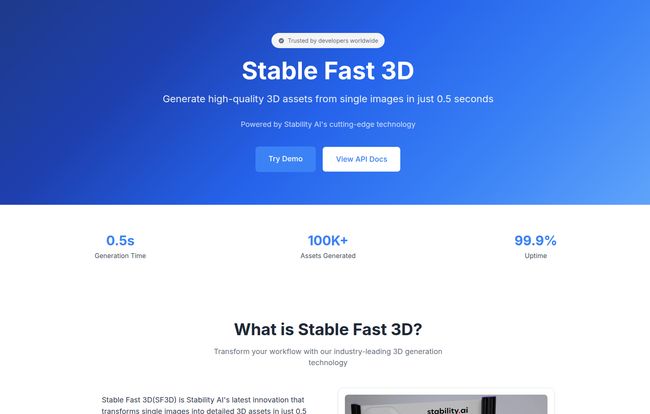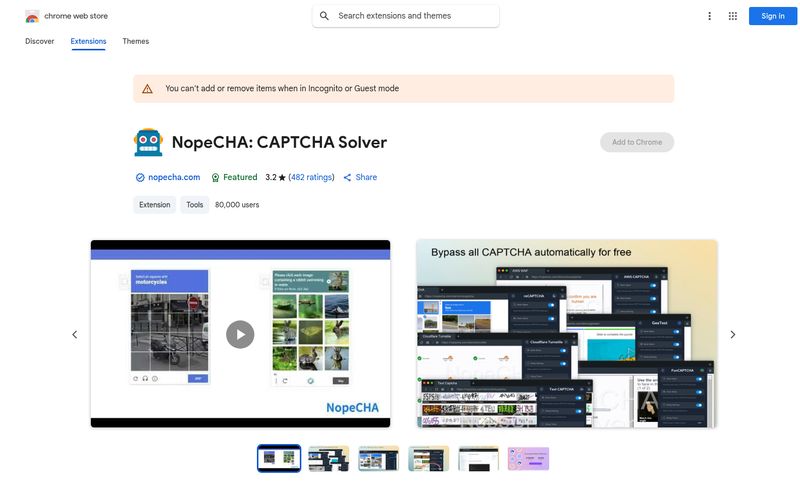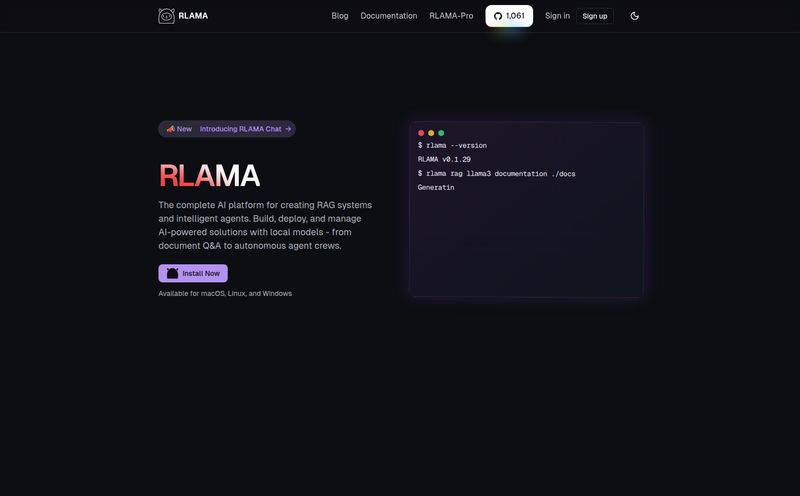I’ve been in the SEO and digital content game for a long time. Long enough to remember when getting a simple 3D model for a client's website felt like commissioning a renaissance sculpture. You’d spend days, sometimes weeks, going back and forth with a designer, tweaking vertices, and waiting hours for renders. So when I see a headline that says “Generate high-quality 3D assets from single images in just 0.5 seconds,” my professional-grade skepticism kicks in. Hard.
But this claim comes from Stability AI, the folks behind Stable Diffusion, so my curiosity won. They’re not exactly some fly-by-night operation. They’ve been at the forefront of this whole generative AI explosion. So, I decided to take a proper look at their new tool, Stable Fast 3D. And let me tell you, what I found is… well, it’s a lot to unpack.
So What Exactly is Stable Fast 3D?
Alright, let's get the elevator pitch out of the way. Stable Fast 3D is a new model that takes a single 2D image—like a photo of a chair, a car, or a coffee mug—and spits out a 3D model of it. The kicker is the speed. They claim it can do this in under a second. That's not a typo. Point-five seconds. It's like having a magical 3D Polaroid camera. You point, you click, and you get a little digital sculpture.
This isn’t just some lumpy, barely-recognizable blob, either. The tool generates textured 3D meshes that are UV unwrapped. For my non-3D-artist friends, that’s a huge deal. It means the 3D model is ready for its close-up; you can easily apply new textures or edit existing ones without pulling your hair out. It’s built for actual workflows, not just as a cool tech demo.

Visit Stable Fast 3D
The Features That Actually Matter
Every new platform boasts a laundry list of features, but I only care about the ones that solve real problems. Here’s what stood out to me from the jump.
Ludicrous Speed Generation
I have to come back to the speed. 0.5 seconds. I've had loading screens last longer. In the time it takes you to blink twice, you can have a usable 3D asset. This completely changes the game for rapid prototyping. Imagine being a game developer and needing a hundred different background props. Or an e-commerce manager wanting to show a product from every angle. The time saved is just immense.
Quality Where It Counts
Speed is worthless if the output is garbage. Thankfully, that doesn't seem to be the case here. The models come with UV unwrapped meshes and decent material parameters. One of the more subtle but brilliant features is the “reduced illumination bake-in.” This means the model’s texture isn’t polluted by the lighting from the original photo. You get a clean, neutrally-lit asset that you can drop into your own scene and light however you want. This is a pro-level detail that many other tools miss.
How You Can Actually Use It
This isn't some walled-off research project. Stability AI has made it accessible in a couple of ways. There's a demo over on Hugging Face where you can play around with it right now. For the more serious users and developers, there’s an API. This means you can integrate this tech directly into your own apps, websites, or creative pipelines. Super smart.
The Good, The Bad, and The GPU-Hungry
No tool is perfect, right? I've been doing this long enough to know there's always a catch. Here's my unfiltered take.
What I’m Genuinely Excited About
The speed and quality combo is obviously the main event. It opens up possibilities for indie creators, small studios, and marketers who don’t have a massive 3D art department. The ability to go from a single reference image to a workable asset so quickly is something I've been dreaming of for years. This is a massive win for creative velocity.
Some Potential Dealbreakers
Okay, here’s the reality check. First, the hardware requirements. To run this thing, you need a GPU with at least 7GB of VRAM. That’s not an entry-level piece of kit. The bouncer at this tech club is pretty picky, so your old laptop probably isn't getting in. This immediately puts a barrier up for a lot of hobbyists and students.
Second, the licensing is… specific. It’s free for non-commercial use and for companies with less than $1 million in annual revenue. That's fantastic for the little guys. But if your organization makes more than that, you have to pony up for an Enterprise license. And they don't list the price, which usually means it's a "if you have to ask, you can't afford it" situation.
Finally, using the API isn't a free-for-all. It operates on a credit system. So, while you can test the waters, heavy-duty commercial use will have a recurring cost. This is pretty standard, but something to budget for.
How Does It Compare to the Other Giants?
The images on their site compare Stable Fast 3D to Google's DreamFusion and NVIDIA's Magic3D. It’s a bold move, but I think it’s a bit of an apples-to-oranges situation. Both DreamFusion and Magic3D are primarily text-to-3D models. You write a prompt like "an armchair in the style of Picasso," and they build it from scratch. It’s an amazing but often slow and unpredictable process.
Stable Fast 3D is image-to-3D. It’s less about pure imagination and more about reconstruction. You’re not creating something from nothing; you're giving form to something that already exists in a photo. In my opinion, this makes it a more practical tool for many commercial applications where you already have a product or concept you need to visualize. It's a different tool for a different job, and it excels in its own lane.
Let's Talk About The Cost and Getting Access
So, how much does this magic cost? It's a bit of a tiered system.
Here's a simple breakdown:
| User Type | Cost & Licensing |
|---|---|
| Personal Use / Researchers / Hobbyists | Free to use the model. |
| Startups & Small Businesses (<$1M Annual Revenue) | Free to use the model. |
| Large Companies (>$1M Annual Revenue) | Requires a paid Enterprise license. You have to contact them for pricing. |
| API Users | Usage requires purchasing credits through the Stability AI Platform. |
I appreciate the creator-friendly approach for smaller entities. It lets the technology get into the hands of people who will do cool, innovative things with it. For bigger companies, it’s a standard enterprise sales model.
Frequently Asked Questions
What kind of stuff can I generate with Stable Fast 3D?
Primarily objects. Think furniture, cars, sculptures, gadgets, shoes—anything that can be captured well in a single, clear photograph. It's less suited for complex scenes or organic things like people and animals, at least for now.
What's the texture quality like?
The output texture resolution isn't explicitly stated, but from the examples, it seems to be decent. The quality will heavily depend on the resolution and clarity of your source image. The fact that it removes baked-in lighting is the real win for texture artists.
What file format does it export?
The documentation mentions it produces a UV unwrapped mesh. This strongly suggests it outputs to standard 3D file formats like .obj or .glb, which are compatible with pretty much every 3D software out there, from Blender to Unreal Engine.
Do I really need a beefy computer?
If you want to run the model locally, yes. The 7GB VRAM requirement for your GPU is not a suggestion. However, you can use the API or the Hugging Face demo without needing any powerful hardware on your end, since their servers do all the heavy lifting.
Is it truly free?
It's free for a lot of people! If you're using it for a personal project, for academic research, or for your startup that's still under the $1M revenue mark, you're in the clear. But for established businesses and heavy API use, there are costs involved. It's a freemium model, essentially.
Final Verdict: Is Stable Fast 3D a Revolution?
So, is Stable Fast 3D the game-changing revolution it claims to be? I'm going to say… yeah, pretty much. It’s not perfect, and the hardware and licensing hurdles are real. But the core technology is just staggering.
For years, we've been moving toward more accessible and faster content creation. This tool feels like a massive leap forward on the 3D front. It's not going to replace skilled 3D artists, but it is going to give them, and many others, an incredibly powerful new tool in their belt. It democratizes a part of the creative process that has always been complex and time-consuming. And for that, I have to give Stability AI a lot of credit. This one is worth keeping a very close eye on.
Reference and Sources
- Stability AI Official Website
- Stable Fast 3D Demo on Hugging Face
- Stability AI Developer Platform (for API access)



